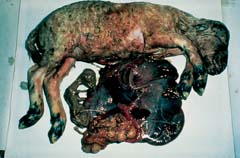Section Links
“Remember: Don't forget to order a new planner each year”
Toxoplasmosis
 Caused by: A Coccidial organism (paratsite) Toxoplasma gondii
Caused by: A Coccidial organism (paratsite) Toxoplasma gondii
How is the disease spread: Environmentally spread, occasionally from animal-to-animal.
The eggs (oocysts) are ingested via forage and feed which have been infected mainly by cats faeces in barns and food stores. Infection can also be via infected manure / bedding which is contaminated, sometimes infection could occur at pasture from eggs in faeces of the intermediate host.
Information: The reservoir of infection in the environment is due to and spread by vermin such as rodents passed from generation to generation. Rodents and birds infected with the cysts are eaten by cats which become immune. In young prior to becoming immune and older cats where the immune system is sub-optimal they excrete the eggs in their faeces and contaminate pasture, food and bedding..
The eggs are durable and can survive for several years!
NOTE: If infected in early pregnancy the ewe may abort or reabsorb the pregnancy ( appear/ show as barren)
Appearance of the abortion: Fresh lambs, mummified foetuses at full term or aborted early, stillbirths and weakly lambs which fail to thrive. The placenta will be thickened/lethery with white spots. The ewe will appear to be OK.
Treatment: Use of in-feed coccidiostat usually throughout pregnancy as the infection can occur at any time if the organisms eggs are ingested – Consult your vet for advice.
Prevention: Aborted ewes can be kept as they will develop immunity to the organism. Adopt the use of vaccine which is administered prior to mating. This is usually a once in a life-time process
How to control the disease: Discuss with your vet a plan to reduce the risk of infection and manage the disease.
Measures to take when abortions occur
More Information on this subject - click here

